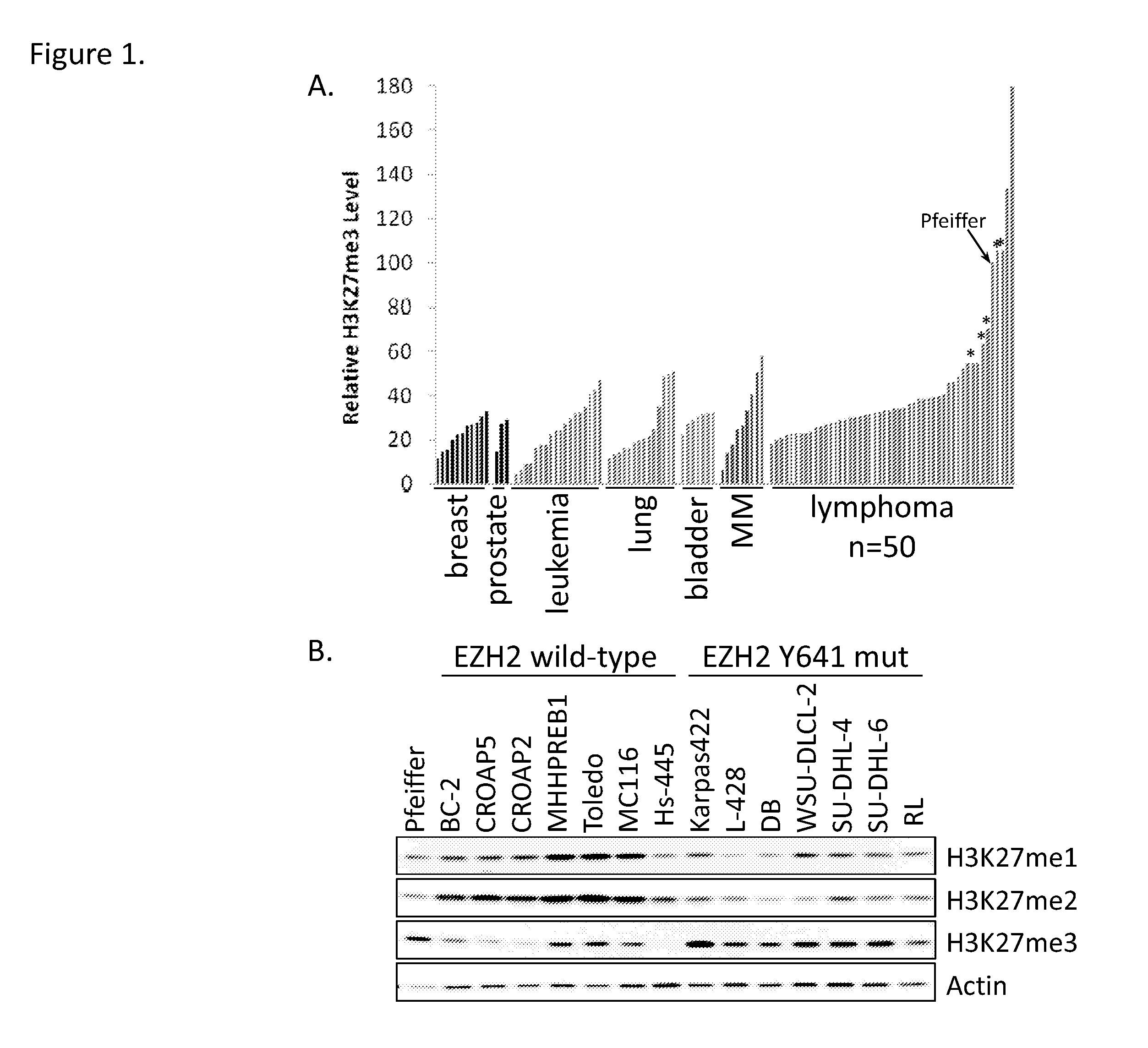Methods of treating cancer
- Summary
- Abstract
- Description
- Claims
- Application Information
AI Technical Summary
Benefits of technology
Problems solved by technology
Method used
Image
Examples
example 1
Cell Culture and Primary Tumor Specimens
[0217]The Pfeiffer DLBCL cell line (ATCC) was maintained in RPMI-1640 media (MediaTech) supplemented with 10% fetal bovine serum (FBS) (Sigma-Aldrich). All other cell line were obtained from either ATCC or DSMZ and maintained in the recommended cell culture media. Genomic DNA for 41 lymphoma patients was sourced from OriGene (Rockville, Md.). DNA was extracted from frozen blocks of pathology-verified tumor tissue with high tumor content (>40%). Tissues were collected for molecular analyses in accordance with IRB approval and patient informed consent. Detailed clinical characteristics of the tumor specimens are presented in Table 2.
example 2
ELISA-based quantitation of histone H3 and H3K27me3 levels
[0218]Cell lines were harvested, rinsed with 1×PBS, and centrifuged. Cell pellets were lysed with 0.2N HCl for 30 minutes to extract histones. The acid insoluble portion was pelleted by centrifugation and the supernatant was neutralized with neutralization buffer (1M Na2HPO4, pH 12.5; ActiveMotif) containing protease inhibitors (Roche). Protein lysates and recombinant H3K27me3 (ActiveMotif) were titrated in neutralized lysis buffer and added to Maxisorp ELISA plates (Nunc) in duplicate on each of two plates. Blocking buffer (1% BSA) was added and plates were incubated for 1 hour prior to being washed 4 times with imidazole buffered saline containing Tween-20 (KPL). Plates were incubated with primary antibodies for H3K27me3 (Cell Signaling Technology) or total H3 (ActiveMotif), washed, and incubated with secondary anti-rabbit IgG HRP-linked antibody (Cell Signaling Technology). Luminata Forte substrate (Millipore) was added 5 ...
example 3
Western Blot Analysis of H3K27 Methylation Status
[0219]Cell lines were rinsed with PBS and lysed on ice with RIPA buffer (Thermo Scientific) containing protease and phosphatase inhibitors (Roche). Lysates were then sonicated for 15 seconds using a Branson Sonifier 150 (setting=2) and protein concentrations were determined with a BCA protein assay (Thermo Scientific). Protein lysates (1-5 □g) were then denatured and electrophoresed on Bis-Tris SDS-polyacrylamide gels (Invitrogen) before being transferred to PVDF membrane (Invitrogen). The membranes were blocked with Odyssey blocking buffer (Li-Cor) and probed with antibodies recognizing EZH2 (BD Transduction Labs), histone H3 (Abeam), H3K27me1, H3K27me3 (Cell Signaling Technology), or Actin (Sigma). After washing with PBS containing 0.1% Tween-20 (PBST), membranes were hybridized with fluorescent secondary antibodies (Li-Cor), washed with PBST, and imaged using an Odyssey infrared imaging system (Li-Cor).
PUM
 Login to View More
Login to View More Abstract
Description
Claims
Application Information
 Login to View More
Login to View More - R&D
- Intellectual Property
- Life Sciences
- Materials
- Tech Scout
- Unparalleled Data Quality
- Higher Quality Content
- 60% Fewer Hallucinations
Browse by: Latest US Patents, China's latest patents, Technical Efficacy Thesaurus, Application Domain, Technology Topic, Popular Technical Reports.
© 2025 PatSnap. All rights reserved.Legal|Privacy policy|Modern Slavery Act Transparency Statement|Sitemap|About US| Contact US: help@patsnap.com



